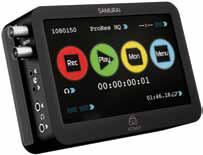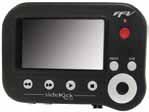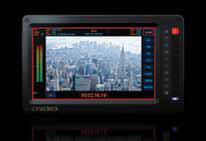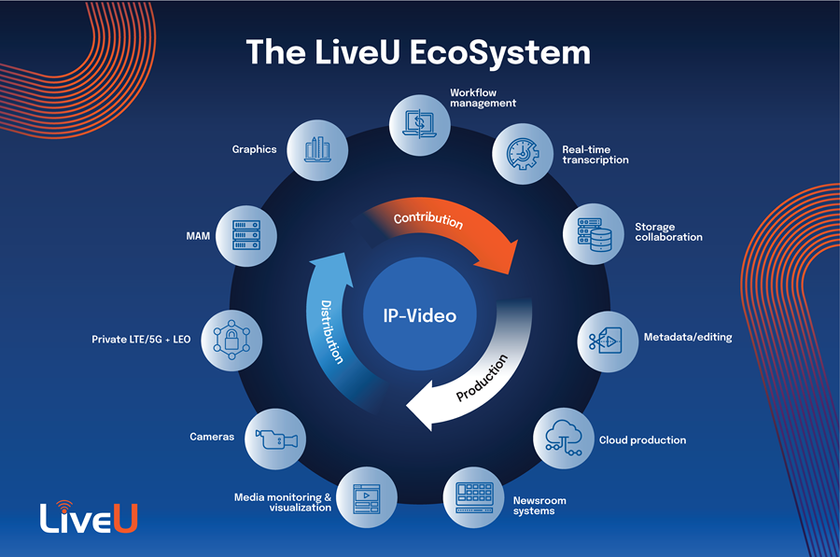Cheating a Camcorder’s Codec
MULTIPLE CITIES - Most “filmmaker” video camcorders have a live HD video output that is active when the unit is powered up. Those camcorders’ video outputs are available in HD-SDI, HDMI or USB 3.0 connectors.
Third-party manufacturers have produced a number of portable recording units designed to capture the output from such connectors in various higher-quality codecs than those built into those camcorders, and a portable recorder may provide access to cheaper or larger-capacity recording media than that for which the camera was designed.
KI PRO LINE
The Ki Pro was one of the first portable recorders to go beyond supplying larger recording times in the camcorder’s native codec. It supports Apple ProRes 422 recording, making it attractive to Final Cut users.
AJA Video Systems Ki Pro
But the ubiquity of ProRes means current nonlinear editing systems can access the captured video easily. AJA Video Systems makes that easier by outfitting the Ki Pro with RS-422 and Firewire 800 machine control so it can also function as the source deck in post-production.
The Ki Pro has a complement of analog and digital video and audio input/output connections and controls for recording, monitoring and playback when powered by batteries in the field or an AC adapter in the studio. As a bonus, AJA built in a number of up-, down- and aspect ratio conversions for HD-to-SD or SD-to-HD situations. Rounding out the Ki Pro features are a local area network connection control, time code I/O and a built-in Web server to make the unit controllable using a standard Web browser and LAN connection.
For users who need something smaller than the Ki Pro, AJA offers the Ki Pro Mini. While the Mini is smaller and lighter than its sibling, it maintains most of the basic recording and play- back features without the up-, down- and cross- conversion capability, the company says.
The Mini does lose the RS-422 control and analog connectors—except for XLR audio input—and it relies on HD-SDI and HDMI for digital I/O and LAN or LANC for control. It also trims size and weight by recording onto two CF cards instead of hard- or solid-state drives. As a bonus for Avid users, the Ki Pro Mini can record directly to Avid DNxHD.
Some of the newer low-cost 4K camcorders— such as the Canon EOS C-500—can image 4K, but not record it onto their on-board media. However, those camcorders do output 4K live on dual-link 3G HD-SDI ports. The Ki Pro Quad, a unit that looks like a fatter Mini, was designed by AJA in collaboration with Canon for just that purpose. The Ki Pro Quad records 4K quad HD, 2K or HD to removable solid- state drives in ProRes 10-bit 4:4:4 or 4:2:2.
NINJA AND SAMURAI

Atomos Samurai
In 2011, newly formed Atomos introduced two field recorders, the Ninja and the Samurai. The recently updated Ninja-2 will record video and two channels of embedded audio from the camcorder’s HDMI output to a removable 2.5-inch hard disk drive or solid-state drive in 10-bit Apple ProRes 422 or Avid DNxHD. One side of the unit presents a touch- screen interface for transport controls and unit set- up that doubles as an input monitor.
In addition, a looped LANC connection is provided for integration with LANC camera control accessories. It also provides two line-in audio inputs and a headphone jack for audio monitoring. Rechargeable batteries—supplied with the unit—power the Ninja, and while it has two battery bays, it runs on a single battery. The single battery power system enables continuous operation during “hot-swap” battery changes. The Ninja ships with a “Master Caddy” into which the HDD/SSD can be inserted after recording for file-based media transfer to a non- linear editing system by SATA, Firewire 800, or USB 2.0/3.0.
The slightly larger Samurai will take 10-bit uncompressed video from an HD/SD-SDI feed instead of HDMI and supports eight channels of embedded audio. The Samurai’s touch screen has almost twice the resolution of the Ninja’s and it provides loop-through output via HD/SD-SDI. Both products ship as kits that include a case, two batteries, charger, two Master Caddies and cables. Add a compatible 2.5-inch HDD/SDD to either of the units and they are ready to record.
SIDEKICK

Fast Forward Video sideKick
Fast Forward Video, one of the first production DVR developers, currently provides Apple ProRes 422 recording in its sideKick HD recorder. FFV plans to support other codecs via optional firmware upgrades, but the sidekick currently features tra- ditional transport control buttons below a 4.3-inch liquid crystal display screen that provides monitoring capability and access to configuration menus.
The sideKick comes with a 128 gigabyte remov- able 2.5-inch SSD, battery, charger, four-to-three- pin power adapter cable, camera shoe mount and carrying case. It supports either HDMI or HD-SDI input with embedded audio and an analog two- channel microphone/line input as well as head- phone output. While the sideKick is ready to shoot out of the box, a 2.5-inch removable drive bay will need to be acquired separately in order to do a file- based media transfer to a NLE system.
CINEDECK EX

Cinedeck EX
Moving up the scale in capability and price, the Cinedeck EX supports all forms and data rates of Apple ProRes, Avid DNxHD, AVC-Intra, XDCam, H.264, legacy Avid Meridian, and Cineform DI codecs as well as 4:4:4 and 4:2:2 uncompressed HD recording from HDMI, HD/SD-SDI single-/dual-link, or LAN to a standard 2.5-inch SSD. Beside the 7-inch touch screen provided for monitoring and control, the EX has a column of 10 physical buttons dedicated to the most common field recording tasks. Its larger size allows it to provide more I/O including a video graphics array monitor port, time code/sync connectors, eSATAp port multiplier with RAID support, USB and a breakout connector that supports I/O for analog video, analog and digital audio plus RS-422 machine control. The Wi-Fi connector and extensive controls provided by the touch screen really make the EX more than a simple cinema grade portable recorder.
PIX 220I/240I
The same is true of Sound Devices' PIX recorders that are available in two variants, the PIX 220i and the PIX 240i, both of which use 5-inch in-plane switching displays for control and monitoring.
The PIX 220i supports only HDMI with four- channel embedded audio input while the 240i supports both HDMI and HD-SDI with eight-channel embedded audio and the 240i adds AES3 digital audio input and eSATAp to support additional external storage. Beyond those differences, the 220i and 240i look nearly identical and support the same functionality.
Sound Devices' PIX 240i
The systems have balanced XLR microphone/line audio input with switchable 48 Vphantom power, and two-channel XLR line-level audio output plus a headphone connector. Power is supplied by two Sony L batteries or by another DC source through a Hirose four-pin connector. If the unit is connected to a DC power supply, but is turned off, it will act as a battery charger.
Lighted buttons below the 5-inch LCD screen pro- vide transport control while four small metal ball buttons, two on each side of the display, provide dedicated function control and set-up menu access. The PIXs can record to either high-speed Cinedeck’s EX.
Beside the 7-inch touch screen provid- ed for monitoring and control, the EX has a column of 10 physi- cal buttons dedicated to the most common field recording tasks.
Its larger size allows it to provide more I/O including a video CompactFlash or standard 2.5-inch SSD in the internal bay or in an optional caddie that can be used for content transfer to Thunderbolt-equipped computers. The PIX-CADDY supports USB 3.0, Firewire 800 and eSATAp connections while PIX recorders can capture to all variations and frame rates of Apple ProRes and Avid DNxHD.
GEMINI 4:4:4
Convergent Design’s Gemini 4:4:4 does what the name implies: It records to high-definition television systems (REC-709) 10-bit uncompressed 4:4:4 or 4:2:2 (QuickTime .mov format) 1080p to two SSDs.
The Gemini’s monitoring and menu control is available through the 5-inch LCD display on system’s side, and the device can be set to record to both SSDs simultaneously for back-up purposes, or it can relay the video to devices providing longer recording times.
Convergent Design's Gemini 4:4:4
Shooters can program the Gemini to over-/ under-crank or record in time-lapse mode. Two HD-SDI inputs support embedded time code and eight-channel audio, and they can be configured as single-link, or dual-link 3G ports. Outputs include two HD-SDI, 3.5-millimeter headphone jack and HDMI. An optional wired remote control can add a locked in time code I/O.
An optional add-on codec includes ARRIRAW, Canon 4K and stereo 3D recording. The newer Gemini RAW includes those options in the base package. Gemini kits include an eSATA “transfer station” for offloading SSDs to a computer or NLE system.
DECISIONS, DECISIONS
In order to preserve as much resolution as an imager can deliver before the camcorder’s native compression degrades it, investigate those and the numerous other portable recorders currently available. Running the price spectrum from sub-$1,000 to $5,000 plus, there are plenty of opportunities to buy less or more than needed, so be sure to consider all environmental and operational use-cases to determine which device best meets the studio’s needs.
Get the TV Tech Newsletter
The professional video industry's #1 source for news, trends and product and tech information. Sign up below.













